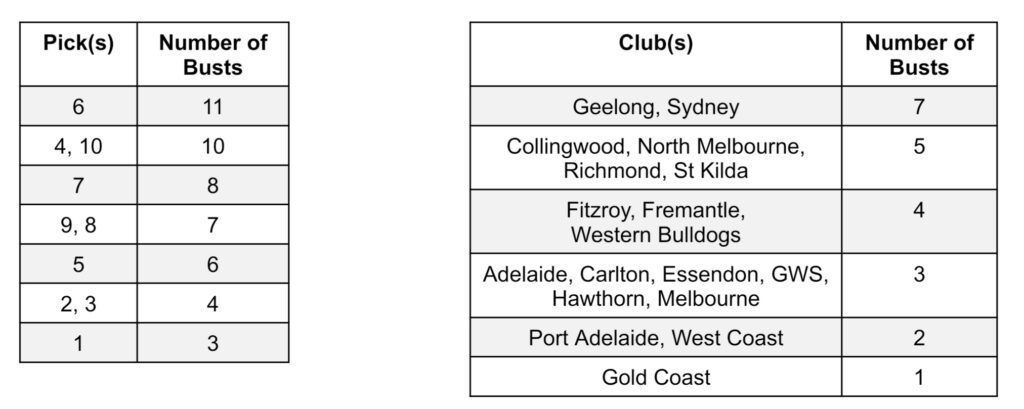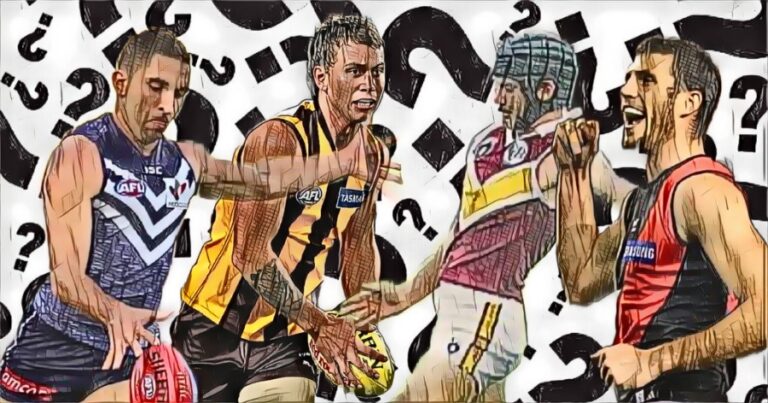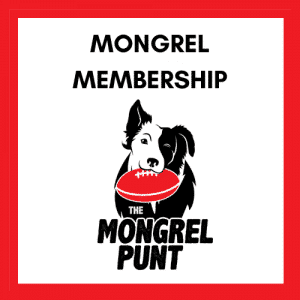Generational talents, superdrafts and the dwindling number of busts in the 2010’s
I want to preface this article by saying that being drafted alone is an incredible feat, and something that many of us growing up in Australia (myself included) dreamt of achieving but due to poor genetics, poor health and / or a plain lack of ability in my case, we didn’t make the grade.
Playing an AFL game is another huge feat, and an even more difficult one at that.
I loathe the term “bust” as it takes away from these incredible achievements. Despite my personal feelings towards the term, it is thrown around football circles almost as much as some other draft cliches such as “generational talent”, “superdraft” and “bolters”.
My friends and I have noticed an interesting trend which appears to be emerging in the AFL when looking back at recent drafts. Less “busts” seem to be taken in the top 10 in recent times with top picks like Sam Walsh, Nick Daicos and Harry Sheezel bursting onto the scene with aplomb. This seems to be a departure from the Beau Dowler, Scott Gumbleton and Jarrad Oakley-Nichols filled drafts of the early 2000’s.
While pondering if this was simply confirmation bias on my behalf, or if the increased emphasis on professionalism in the AFL which has filtered down to junior football has made a significant difference, I decided I needed some metrics to test this hypothesis.
First a few ground rules:
- No mini drafts, pre-drafts or rookie drafts.
- Only the top 10 picks of each year’s national draft count (there are a few years in the 1980’s where no draft was held).
- I know comparing the 1990’s to the 2010’s isn’t fair. I’m doing it anyway.
Valuing Each Draft Pick

The table above shows the approximate average games played and Brownlow votes polled in a career for the draft picks in the top 10.
Obviously this isn’t perfect, as the drafts of recent years skew the averages downwards but I am in generous mood so let’s not exclude recent drafts from the average figures.
That being said, I will not be analysing the top 10 of the last 4 drafts (2020, 2021, 2022 and 2023). This is in part to be fair to the young players still trying to find their way in the league, and also to remove the COVID tainted 2020 draft. I think if we could all wipe that strange COVID period from existence we would.
Bust Criteria
For those living with their heads buried in the sand, like an Essendon supporter during the infamous “supplements saga”, generally speaking, a bust is a player who failed to meet the expectations of them prior to being drafted.
However, I don’t think this accounts for players who forge out a decent career despite not quite meeting the sometimes extremely lofty expectations placed on them as a teenager.
In my mind, a bust is someone who not only didn’t meet the expectations of them, but someone who failed to even make a mark on the league. Someone who will be lost to time and the game will forget. Someone who was drafted one minute, and gone the next.
That’s a pretty flimsy definition, so let’s try to make it a bit more concrete for the purposes of this analysis. For the rest of this article, a bust will be a player who has less than (approximately) 25% of the average career totals for their draft pick in both career games played and Brownlow votes, as shown below:

For example, for a former Pick 1 to be a bust, they must have played less than 49 games and polled less than 12 Brownlow votes in their career.
Does the Bust Criteria Work?
Great work Jed – You pretended to do a bit of math, and made up some parameters based on a whim. The question is, does this actually work?
Well, let’s look at some former pick ones to illustrate how it works:

I am reasonably happy with the outcome here.
Anyone calling Luke Hodge a bust wouldn’t want to stop by Colac any time soon.
Watts, Boyd and McCartin underwhelmed for various reasons given the first pick was used on each of them in their respective drafts, but I think they have all had respectable on-field careers.
John Hutton I had never heard of before today, so apologies if a Hutton family member is reading this but for my purposes he was a bust.
Seems fair to me.
The Busts
- 1981: Neil Craig (Pick 2, WB), Grant Campbell (Pick 3, STK), Peter Hofner (Pick 6, RICH).
- 1982: Baden Harper (Pick 4, GEEL), Keith Thomas (Pick 5, MEL), Peter Motley (Pick 6, SYD).
- 1986: Steven Sims (Pick 2, STK), Richard Anderson (Pick 4, RICH), Michael Taylor (Pick 5, GEEL), Chris Lindsay (Pick 7, NM), Andrew Payze (Pick 9, ESS), John Brinkkotter (Pick 10, SYD).
- 1987: Richard Lounder (Pick 1, RICH), Michael Quirk (Pick 5, STK), Darren Jones (Pick 8, GEEL), Michael Murphy (Pick 9, NM).
- 1988: Carl Dilena (Pick 3, FITZ), John McNamara (Pick 4, NM), Ray Sterrett (Pick 6, GEEL), Peter Higgins (Pick 10, WC).
- 1989: Jody Arnol (Pick 3, STK), Stephen Edgar (Pick 7, CARL), Daryl Groves (Pick 10, COLL).
- 1990: Stephan Hooper (Pick 1, GEEL), David Donato (Pick 3, FITZ), Stewart Devlin (Pick 5, GEEL), Damian Hampson (Pick 7, CARL), Paul Gow (Pick 8, WB), David Ogg (Pick 10, BL).
- 1991: John Hutton (Pick 1, BL), Paul Burton (Pick 6, SYD).
- 1992: Jason Spinks (Pick 5, SYD), Wayne Hernaman (Pick 7, RICH).
- 1993: Glenn Gorman (Pick 4, SYD), Trent Cummings (Pick 6, FITZ), Michael Frost (Pick 8, STK).
- 1994: Robert McMahon (Pick 6, FITZ), Ben Wilson (Pick 9, COLL).
- 1995: Ben Edwards (Pick 7, FRE), Allen Jakovich (Pick 9, WB).
- 1996: Mark Kinnear (Pick 4, SYD), Daniel McAlister (Pick 5, ESS), John Rombotis (Pick 6, PA), Leigh Brockman (Pick 8, GEEL), Mark Harwood (Pick 9, PA).
- 1997: Nil.
- 1998: Ryan Fitzgerald (Pick 4, SYD), Murray Vance (Pick 6, CARL), Brandon Hill (Pick 10, WC).
- 1999: Danny Roach (Pick 7, COLL).
- 2000: Dylan Smith (Pick 6, NM), Laurence Angwin (Pick 7, ADEL).
- 2001: Luke Molan (Pick 9, MEL).
- 2002: Tim Walsh (Pick 4, WB), Luke Brennan (Pick 8, HAW).
- 2003: David Trotter (Pick 9, NM), Rhyley Dunn (Pick 10, FRE).
- 2004: John Meesen (Pick 8, ADEL), Chris Egan (Pick 10, COLL).
- 2005: Beau Dowler (Pick 6, HAW), Jarrad Oakley-Nicholls (Pick 8, RICH), Marcus Drum (Pick 10, FRE).
- 2006: Scott Gumbleton (Pick 2, ESS), Mitch Thorp (Pick 6, HAW).
- 2007: Nil.
- 2008: Nil.
- 2009: Anthony Morabitto (Pick 4, FRE).
- 2010: Daniel Gorringe (Pick 10, GC).
- 2011: Nil.
- 2012: Jonathan O’Rourke (Pick 2, GWS), Jimmy Toumpas (Pick 4, MEL).
- 2013: Nathan Freeman (Pick 10, COLL).
- 2014: Jarrod Pickett (Pick 4, GWS), Paul Ahern (Pick 7, GWS).
- 2015: Nil.
- 2016: Nil.
- 2017: Nil.
- 2018: Nil.
- 2019: Fisher McAsey (ADEL).
Random Findings Which Amused Me
Now, I imagine anyone reading this shares my love for football, but might not share my love for stats (if you do you should read the great book Footballistics by James Coventry).
To avoid losing any readers who have made it thus far, and to maintain my very limited street cred, I am not going to bore you with the detail of whether every player taken with a top 10 draft pick in every draft since 1981 (yes I spent my time going through them all) was a bust according to the Bust Criteria.
I will however share some interesting and noteworthy findings of my research before getting to the final results:
- What could have been: Peter Motley (Pick 6, 1982) was a bust. He played 19 career games and was named All Australian twice. Tragically, his career was cut short due to a serious car crash at just the age of 22.
- Poor Fitzroy: The top 5 picks in the 1996 draft (Jeff White, Anthony Rocca, Shannon Grant, Scott Lucas and Joel Smith) combined for 1302 games played and 243 Brownlow votes polled. Robert McMahon (Pick 6) tallied just 2 games and polled 0 Brownlow votes for Fitzroy. Ouch.
- The Original Superdraft: Not a single bust was taken in the top 10 of the 1997 Draft, who combined for a whopping 2,153 career games and 315 Brownlow votes. 8 Premierships and 6 All Australians between this cohort too is handy return.
- Unblemished: The 1997, 2007, 2008, 2011 and 2015-2018 Drafts all did not feature a single bust in the top 10 picks.
- Best Pick: Pick 1 had the least busts with 3 total. Perhaps this is partially attributable to the sunk-cost fallacy, where clubs are likely to give their top picks more chances to show their wares, particularly if they invest the first pick of a draft.
- Worst Pick: Interestingly, Pick 6 (and not Pick 10) was the worst pick with a total of 11 busts. Denver Granger Barrass (Pick 6, 2020) fell outside the range of this article, but looks like he may have also fallen to the Pick 6 curse unless he can turn his fortunes around this year.
- Notable Busts: Ryan ‘Fitzy’ Fitzgerald (Pick 4, 1998) and Daniel Gorringe (Pick 10, 2010). The correlation between being entertaining and a bust might need to be the next hypothesis I test.
- Notable Non-Busts – Cale Morton (Pick 4, 2007), John Butcher (Pick 8, 2009) and by the skin of his teeth Liam Sumner (Pick 10, 2011).
Do the Results Prove Anything?
First, this article proves that I have too much spare time.
Second, kind of.
After Paul Ahern (Pick 7, 2014) failed to live up to expectations at AFL level (save for Round 19 at Bellerive Oval where he had 37 disposals against West Coast and polled his only career Brownlow vote), there was not a single bust until Fisher McAsey (Pick 6, 2019) was taken by Adelaide five years later. Even McAsey did not appear to be a bust by lack of talent, as he retired in 2023 due to losing his love for the game.

The average number of busts taken per draft has continued to trend downwards over the years which aligns with the increased investment in and emphasis placed on junior football talent pathway programs.
However, not only is the average number of busts taken per draft decreasing, the amount by which it is decreasing over the decades is accelerating. This is impressive, given that the closer you get to 0 the more difficult it is to decrease the number of busts, and a single bust will skew the average greatly.
Another interesting point to note is that Gold Coast, who are generally believed to have wasted their bevy of early selections and concessions given to them when they joined the league, only had 1 bust according to the Bust Criteria. This demonstrates that the Bust Criteria rewards simply playing, rather than requiring players to play well. This is a difficult variable to control for.
Clubs like Gold Coast, Carlton and Melbourne (3 busts each) show another factor which my Bust Criteria struggles to account for. Teams which are perennial cellar-dwellers for a period of time such as Melbourne and Carlton in the 2000’s and Gold Coast in the 2010’s, have the ability to give an extended run of games to their draftees regardless of their form. This has allowed some otherwise dubious draft selections to escape the bust label based on the Bust Criteria. I’m looking at you Cale Morton and Jack Trengove.
Conversely, Geelong and Sydney (7 busts a piece) are clubs who have reputations for being savvy drafters and exceptional developers of talent. However, as they had the majority of their early picks in the 1980’s and 1990’s when drafting busts was most prevalent, they were the clubs with the most busts in this analysis.
By the Numbers

Watch out for Tassie
What I will say, is that if I was an AFL club I would be extremely fearful of Tasmania’s impending expansion side given the trend identified above.
You would imagine that given the Gold Coast and GWS concessions didn’t lead to any prolonged success for either club, Tasmania will be given an equivalent if not enhanced leg up to begin with.
If I was running an AFL club I would be doing all that I could to ensure that my team is in the pointy end of the ladder when Tassie joins the competition, as they will likely hoard a majority of the top 10 picks in their first few drafts and given the improvement in AFL drafting this article shows, they will likely hoard the best players with those top picks.


